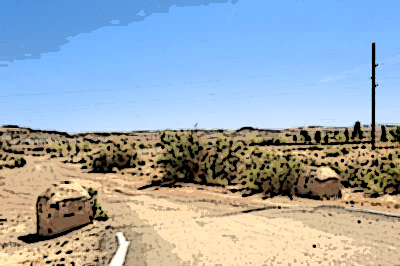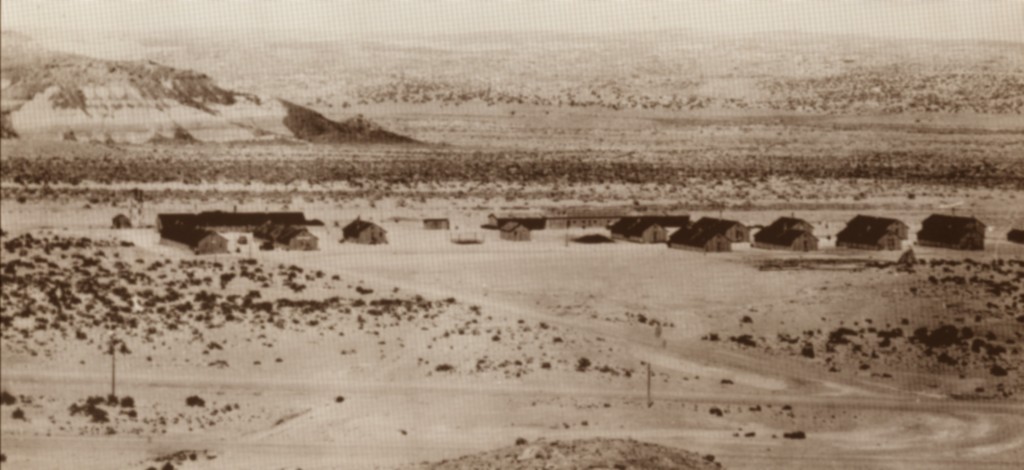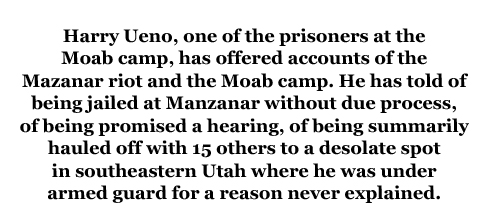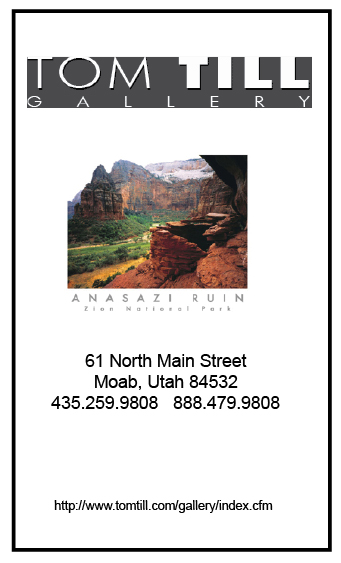Do you remember reading in your histories of World War II about the concentration camps set up by Hitler and Stalin? They incarcerated many of their citizens without benefit of due process because of these peoples’ political beliefs and racial ancestry, and because they were suspected of presenting some sort of vague danger to the country.
It happened here too. Would you believe that in our fair Canyonlands there was a similar camp set up by Americans and dedicated to the imprisonment of citizens of Japanese ancestry? The only things missing were the Siberian winters and the German gas chambers.
World War II was a traumatic experience for most of the world’s population; millions were killed and maimed on the battlefields and in the cities and villages of the combatants. Only in the continental New World did the noncombatants avoid the direct effects of war to any great extent–with the exception of our citizens of Japanese descent. Here in the continental United States of America, bastion of liberty and freedom, the Japanese-Americans were taken from their homes, herded like cattle, put behind barbed wire, and guarded by machine guns and rifles in so-called “relocation centers” by a government paranoid with fear of sabotage and fifth-columns, believing in an imminent invasion by the Japanese Imperial army and goaded by racist opportunists eager to take over the newly abandoned homes, farms and businesses.
This was a sad period in American history, one little known to most Americans until recently. War hysteria, greed, racism and ignorance fueled the re-location. At least 110,000 West Coast Americans of Japanese decent, both citizens and immigrant aliens, suffered and endured the loss of property, civil and human rights, liberty, dignity and self-respect.
 The 11 relocation camps, including one in Utah near Delta called Topaz, were quickly established by the War Department and turned over to the War Relocation Authority in the mid-1942. Few, if any, major problems developed in moving the Japanese-Americans out of the Pacific Coastal area to the camps east of the Sierra Nevada. These were times of confusion. Families were broken up, loyalties to family and country were severely tested, and rumors, lies, half-truths and intimidation were more prevalent than truth and orders.
The 11 relocation camps, including one in Utah near Delta called Topaz, were quickly established by the War Department and turned over to the War Relocation Authority in the mid-1942. Few, if any, major problems developed in moving the Japanese-Americans out of the Pacific Coastal area to the camps east of the Sierra Nevada. These were times of confusion. Families were broken up, loyalties to family and country were severely tested, and rumors, lies, half-truths and intimidation were more prevalent than truth and orders.Pressures on the internees were constant from within and without as the authorities demanded loyalty oaths, encouraged resettlement further inland and split up families for one reason or another. At the same time, the army was proselytizing the young males to fight the war in Europe in the 100th Infantry Battalion and the 442 Regimental Combat Team, or to join the Military Intelligence Service and serve as interpreters and translators of the Japanese language in the Pacific Theater of Operations. All of the young men who did so served with distinction and honor despite the treatment of their relatives.
By the fall of 1942 the numbness of relocation had worn off and reality had set in. No sabotage or invasion had taken place but the internees realized, or at least some of them did, that they were to be imprisoned for the duration and there was to be no recourse to legal institutions.
One of the first camps to erupt was at Manzanar, California. Mess hall workers, incensed by illegal appropriation of scarce sugar and beef by camp authorities, organized a unified small group to communicate with the camp directorate. An accused Japanese-American informer to the FBI was beaten by camp inmates. So-called “ring leaders” of the mess hall workers were jailed over the beating which lead to a demonstration on December 6, 1942 to free these men. The demonstration got out of hand, apparently because of green, trigger-happy soldiers, and two inmates were killed.
The War Relocation Authorities solution was to place 16 Japanese-American citizens in an old Civilian Conservation Corps camp near Moab, Utah.
 A terse announcement in the December 31, 1942 local Times-Independent newspaper informed locals that a contingent of Japanese from Manzanar were to be placed in the old Dalton Wells camp and would arrive by train at Thompson. The locals were told that between 25 and 50 men would be placed there with Army Military Police on guard, 24 hours a day. Later up to 200 more internees might be put in the camp but they would not be allowed to visit Moab according to the news release. Ray R. Best was named as the camp director. It was suggested that, in the future, the Japanese-Americans might work on range projects and that their families might join them–options never really considered but a nice pap for the locals.
A terse announcement in the December 31, 1942 local Times-Independent newspaper informed locals that a contingent of Japanese from Manzanar were to be placed in the old Dalton Wells camp and would arrive by train at Thompson. The locals were told that between 25 and 50 men would be placed there with Army Military Police on guard, 24 hours a day. Later up to 200 more internees might be put in the camp but they would not be allowed to visit Moab according to the news release. Ray R. Best was named as the camp director. It was suggested that, in the future, the Japanese-Americans might work on range projects and that their families might join them–options never really considered but a nice pap for the locals.
The official reason for the camp was reported in the January 14, 1943 Times-Independent as an impound center for troublesome Japanese-Americans who had caused friction in the large relocation centers and had refused to obey community rules in those centers. It was further reported that the first contingent would include the “ring leaders” in a riot “between Japanese groups” at Manzanar. Sixteen Japanese-Americans arrived guarded by Lt. Knuckles (Knuckler,) Lt. A.L. Pomeroy, and 16 MPs.
Harry Ueno, one of the prisoners at the Moab camp, has offered accounts of the Mazanar riot and the Moab camp. He has told of being jailed at Manzanar without due process, of being promised a hearing, of being summarily hauled off with 15 others to a desolate spot in southeastern Utah where he was under armed guard for a reason never explained. Mr. Uno, like many of the Moab prisoners, was a Kibe–one, though born in the United States, who had received part of his education in Japan. As a result, he had a different, perhaps a more Japanese and worldly view of life than the other Japanese-Americans. This presented problems for the authorities as the Kibe were more outspoken and the authorities obviously had a very limited understanding of these “boys” as they referred to them, or of the culture of the first and second generation Japanese in America (Issei and Nisei). The Moab camp inmates were mostly well educated men, some of whom had fought for America in the first World War, and who were simply questioning the right of the government to place them in prison without a given reason, in violation of their civil rights and without any sort of hearing.
Former Park Ranger, Archeologist, and curmudgeon, Lloyd Pierson, resides in Moab, Utah.
To read the PDF version of this article, click here.
Don’t forget the Zephyr ads! All links are hot!








As a visitor to a concentration camp, learning exactly what happened in them, and seeing the aftermath I have a difficult time comparing internment camps with them. I agree, what was done to the US citizens because of their ancestry was wrong, this is apparent and obvious; a blight on this country’s actions during WWII.
The comparison, made by the author, implies two differences. “Siberian winters and the German gas chambers.” Seeing, in person, Dachau, located in southern Germany, I wonder if the author has forgotten about a few things: The pulling of all gold teeth, The confiscation of all valuables of any kind, The force labor until death in many cases, or the separation of families to ensure compliance of the prisoners.
I have educated myself in depth on WWII, especially concerning the concentration camps the German’s used to exterminate, oh there is another thing the author barely hit upon when comparing the two, of so many innocents. Call it what it is but using terminology to justify your ulterior motive, especially when the truth is far more than enough, if a fallacy and a disservice to the people who suffered both in “Concentration Camps” and in “Internment Camps.”.
[…] Historic photo of Dalton Wells from http://www.canyoncountryzephyr.com/2012/06/01/moabs-concentration-camp-from-the-zephyr-archives-by-l… […]